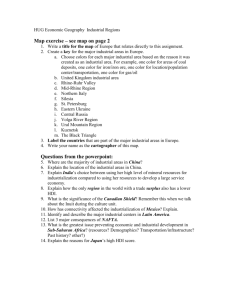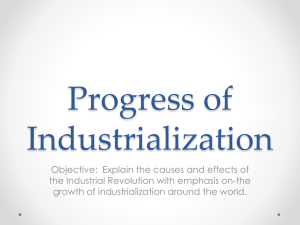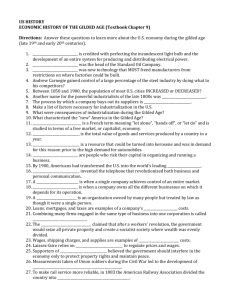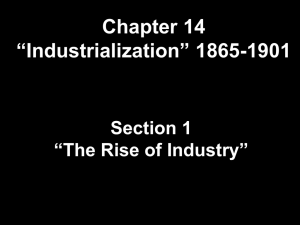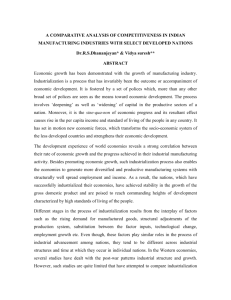1.10 Causes of Industrialization
advertisement
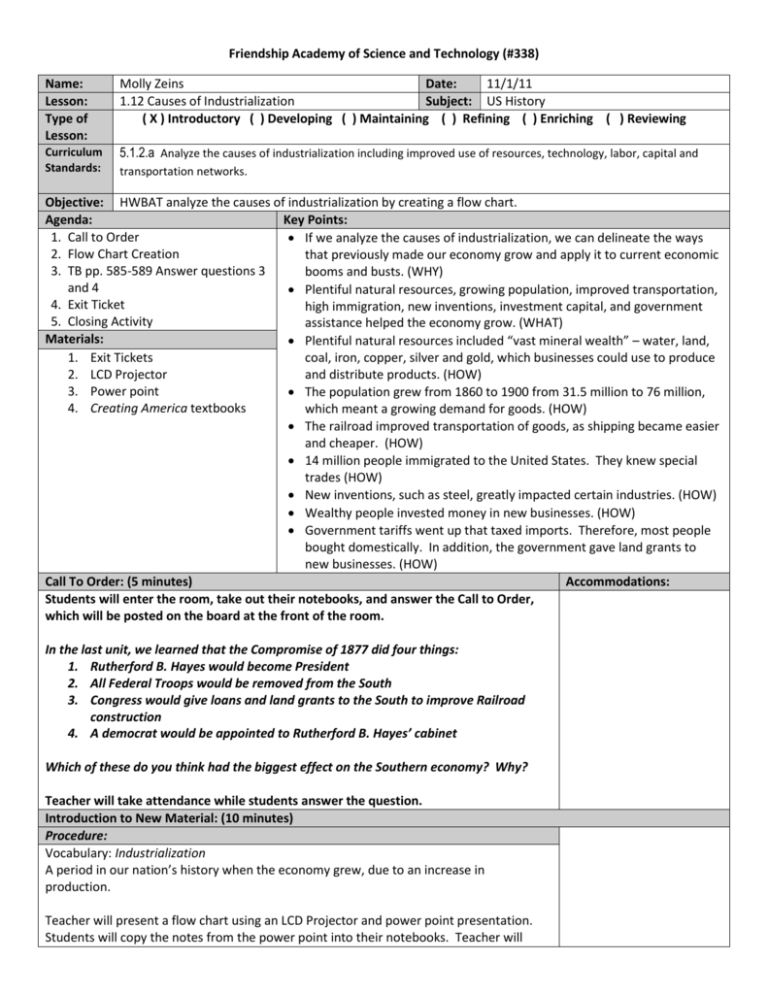
Friendship Academy of Science and Technology (#338) Name: Lesson: Type of Lesson: Molly Zeins Date: 11/1/11 1.12 Causes of Industrialization Subject: US History ( X ) Introductory ( ) Developing ( ) Maintaining ( ) Refining ( ) Enriching ( ) Reviewing Curriculum Standards: 5.1.2.a Analyze the causes of industrialization including improved use of resources, technology, labor, capital and transportation networks. Objective: HWBAT analyze the causes of industrialization by creating a flow chart. Agenda: Key Points: 1. Call to Order If we analyze the causes of industrialization, we can delineate the ways 2. Flow Chart Creation that previously made our economy grow and apply it to current economic 3. TB pp. 585-589 Answer questions 3 booms and busts. (WHY) and 4 Plentiful natural resources, growing population, improved transportation, 4. Exit Ticket high immigration, new inventions, investment capital, and government 5. Closing Activity assistance helped the economy grow. (WHAT) Materials: Plentiful natural resources included “vast mineral wealth” – water, land, coal, iron, copper, silver and gold, which businesses could use to produce 1. Exit Tickets and distribute products. (HOW) 2. LCD Projector 3. Power point The population grew from 1860 to 1900 from 31.5 million to 76 million, 4. Creating America textbooks which meant a growing demand for goods. (HOW) The railroad improved transportation of goods, as shipping became easier and cheaper. (HOW) 14 million people immigrated to the United States. They knew special trades (HOW) New inventions, such as steel, greatly impacted certain industries. (HOW) Wealthy people invested money in new businesses. (HOW) Government tariffs went up that taxed imports. Therefore, most people bought domestically. In addition, the government gave land grants to new businesses. (HOW) Call To Order: (5 minutes) Accommodations: Students will enter the room, take out their notebooks, and answer the Call to Order, which will be posted on the board at the front of the room. In the last unit, we learned that the Compromise of 1877 did four things: 1. Rutherford B. Hayes would become President 2. All Federal Troops would be removed from the South 3. Congress would give loans and land grants to the South to improve Railroad construction 4. A democrat would be appointed to Rutherford B. Hayes’ cabinet Which of these do you think had the biggest effect on the Southern economy? Why? Teacher will take attendance while students answer the question. Introduction to New Material: (10 minutes) Procedure: Vocabulary: Industrialization A period in our nation’s history when the economy grew, due to an increase in production. Teacher will present a flow chart using an LCD Projector and power point presentation. Students will copy the notes from the power point into their notebooks. Teacher will check for understanding by asking students how each contributing factor might have influenced industrialization before filling in the bubble. Guided Practice (20 minutes) Students will work on their own, reading pages 585-589 and answering questions 3 and 4 in their notebooks. Teacher will go over 3 and 4 at the end of class. Independent Practice: (35 minutes) Students will answer a four question exit ticket. Closure: (5 minutes) Teacher will ask students for key concepts to put on the Unit wall. Homework: TB pp. 400-403, answer all questions on a separate sheet of paper. Assessment: Rigor: Notes: Engagement: Intervention:





